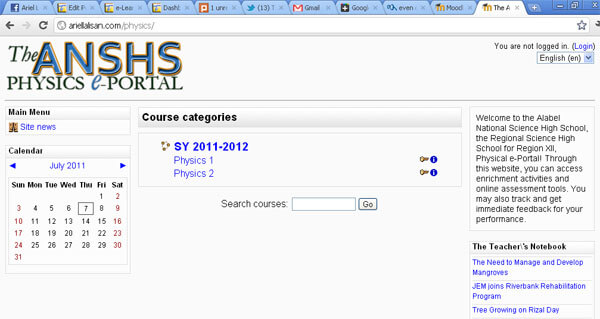THERE’S A gazillion of learning opportunities in the web today and if we can only harness its full potential, we can enhance the students’ learning experience and, consequently, improve their performance.
There is wisdom behind the Department of Education’s Cyber Education Project (CEP). Had traditional politicians [namely, … (just kidding)] kept their hands off it, 90% of the public schools would have been connected to the web now, or we would have have better ICT facilities now.
You may view this presentation on slideshare to better understand it.
We are very fortunate today that we have access to a vast source of information. I sometimes think that it would be my liability as a teacher if I do not let my students experience the beauty of learning from online resources or if they don’t benefit from this excellent information technology.
From my first year of teaching, I have had several attempts at letting my students access information from the internet and perform activities using online resources and I wanted to measure its impact on my students’ learning but I have a hard time tracking the results.
For more than a year now, I have been trying to learn how to administer learning activities through Moodle , the same system that is being used by the University of the Philippines Open University (OPOU).
This year, using an online hosting and domain I won from a blogging contest, I launched the ANSHS Physics e-Portal, using Moodle. On its beta phase, I hope come up with protocols in administering the e-Portal and for successful integration of the e-Portal in the physics curriculum of the school.
Enhanced Learning Experience
Students love the internet. They love to connect with their friends online. They love doing a lot of different stuff like music and gaming. I’d like to view e-Learning as turning the environment that students love into an environment for learning.
Through the e-portal, I can upload Sharable Content Object Reference Models (SCORMs) version of our lesson or enrichment activities, which students can interact with.
Students can also create forums and reply to forum threads where they can have further discussions about topics in physics. Online forums break the barrier of lack of self-confidence that some students show while inside the classroom. Through this, I hope to get the students involvement in informal discussions, while igniting their interest in the field.
Students can also take practice quizzes that can give them immediate feedback. They can also answer test questions that allow them to browse the web for answers, and then they make judgment as to whether the information is enough to answer the question or not, thus, improving their skill in finding valuable information on the web and sharpening their critical thinking about the information they find.
The e-portal will also link my students to other valuable resources online and to the repository of the presentations (PPT & Flash) we discuss in the classroom.
With the e-portal, the students’ learning and interaction are not confined within the school premises.
Challenges
Majority of my students have internet connection at home. Still, there are others that have no access to the internet at home. This means, only those who have their personal internet connection that can make the most our of the e-portal. To even out the playing field, I have to schedule online activities in our computer laboratory (and soon our e-library if the project succeeds). Even so, those who have internet connection are still at an advantage because they can revisit the activities at home.
Another challenge we have is that we don’t have a dedicated internet connection. There are times that the connection is very slow that it limits our online activity. The students cannot perform the activity as planned and time is wasted. Worse, we experience brownout from time to time.
I hope to get more support from the school and from external stakeholders for this effort so that we will be able to maximize our use of the information technology in improving our students’ academic performance.









